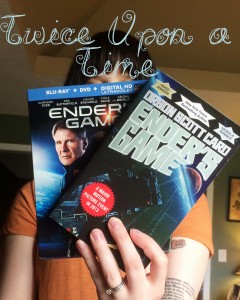For my first book to film compare/contrast, I am going to look at Ender’s Game by Orson Scott Card and the 2013 movie adaptation.

I am going to preface this with two things:
First: There will be spoilers in this post, so if you are planning on reading or watching and don’t want to be spoiled on some points, then you may want to skip or skim. There aren’t mah-jah spoilers, but still a few.
Second: I don’t agree with OSC’s stance that made a huge controversy when the film came out. What is so strange to me is the Ender series is all about open-mindedness, peace, and accepting of others, no matter what. This seems to clash directly with some of OSC’s personal life, which is odd and a bit confusing. However, Ender’s Game focuses on peace, the sacrifice of war, and the consequences of acting without thinking or speaking.
This book, in particular, is a great pacifist story and shows that we should always wait to attack someone in an all out war until we make sure we talk with them and get to know them. Because, by doing so, we might just be able to avoid a war. Maybe a bit too idealist, but as a strong pacifist, I really like the idea.

Now let’s jump into the compare/contrast of the book to film:
1. Valentine and Peter are Almost Completely Cut from the Film, but it Works
In Ender’s Game, there is this whole political drama that unfolds back on earth that Ender has no clue about. Valentine and Peter, Ender’s siblings, take on pseudonyms and begin writing political material that starts to anger the governments in charge and rally the people. Without saying too much, Locke and Demosthenes write some pretty incredible material and it plays a huge part in the rest of the book and in the later books. This deviation from Valentine and Peter’s larger roles actually works really well because it would’ve taken more away from the larger story. I did miss that aspect in the film, but it was still a good choice to leave it out.
2. Ender is Significantly Older in the Film than Book
This seems to happen in a lot of book to film/TV adaptations. See also: A Clockwork Orange and Game of Thrones. This aging up is always a good idea for these stories because of the material at hand. Ender is actually 6 at the beginning of the book, yes SIX, and it makes the book and military that much darker. Especially since we’ve watched as other governments have used children soldiers, in real life, over the decade (more actually, but we began noticing it with more media coverage).

3. Ender Isn’t Quite as Prone to Violence in the Film
One of the reasons Ender is chosen for battle school to be “the one” to lead humans to victory is due largely to his violent tendencies, but also because of his ability to control those tendencies. In the book, Ender is a bit more psychopathic with his violence and ends up killing two other kids. In the film, they show the kids as being severely injured, and hint that one might die, but it is never shown how much of a killer Ender already is. The military wants this because they want annihilation of the buggers (Alien baddies) and they need someone willing to do that. Obviously, this book wasn’t intended for a young audience, but it did get picked up as one shortly after it was published! This is largely because of Ender’s age. The age of the protagonist doesn’t always mean it is for that age group, again see A Clockwork Orange (Alex is 14 or 15 in the book, if I remember correctly).
4. Wait, Battle School?
A huge part of Ender’s story is hanging out, practicing, and living at Battle School. In the book, we watch as he progresses through the various training aspects and how the leaders psychologically manipulate him. It takes a while for this progression, giving you more of a glimpse into the minds of the leaders, as well as into Ender’s mind. And if you read Ender’s Shadow, Bean’s mind. While in the movie, Ender’s stay in Battle School is rushed. One of the main reasons is to keep all the same actors because, in the book, they all start out very young and grow up (ish) before going to Command School. However, I don’t feel like this is a bad thing. It kept a great flow that couldn’t have been captured if they followed the book exactly.
5. In the Film, Ender Becomes Friends with Bean Quickly
In the books, Ender doesn’t befriend anyone quickly. He is standoffish, plus the leaders are trying to single him out and isolate him. In the film, Ender becomes friends with other students fast, but the one that stands out is Bean. They don’t initially get along or are even interested in being around each other, but throughout the book, they do grow in appreciation of each other. This eventually creates a powerful friendship. I actually really like Ender’s Shadow for this reason. You see more of what is going on in Battle School because Ender’s Game only focuses on Ender’s thought processes and what he sees. Bean (Ender’s “shadow”) focuses on a lot of things going on, and that particular book adds a whole different flair to the original text.

There you have it! Some of the major differences from book to film of Ender’s Game! I skipped out on some of the larger (especially ending) differences for spoiler sake.
Have YOU Read and Watched Ender’s Game?
Did I Leave Any Changes Out?
Well, that’s it for my first Common Room post! I hope you enjoyed it. Stay tuned for my next compare/contrast.
Fun Fact: Common Room’s very first podcast episode was about the idea of separating creators from their creations and we used Ender’s Game as the main focus.
Second Fun Fact: you can buy merchandise with Katy‘s beautiful artwork on Redbubble!

